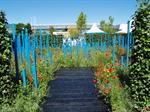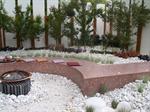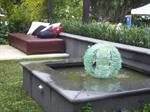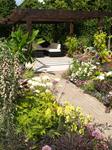Using Colour To Create A Vibrant And Lively Garden
 Some people like serenity in their garden, but others want an environment that is vibrant and lively. It all depends on the sort of person you are, and the sort of environment you want to create around yourself. Extroverts probably lean towards vibrant gardens, whereas introverts usually prefer a more subtle landscape. Other life influences can affect the mood you wish to create in your garden. For example, if you are in a stressful job during the week, you may seek solace and relaxation in your garden. The most important thing is to allow your garden to reflect your personality. Don’t choose your colour scheme impulsively, but give it careful consideration. We all experience mood swings to a greater or lesser degree, but these do not adequately reflect our underlying feelings. If you are not sure, try looking at other gardens and discover how they make you feel.
Some people like serenity in their garden, but others want an environment that is vibrant and lively. It all depends on the sort of person you are, and the sort of environment you want to create around yourself. Extroverts probably lean towards vibrant gardens, whereas introverts usually prefer a more subtle landscape. Other life influences can affect the mood you wish to create in your garden. For example, if you are in a stressful job during the week, you may seek solace and relaxation in your garden. The most important thing is to allow your garden to reflect your personality. Don’t choose your colour scheme impulsively, but give it careful consideration. We all experience mood swings to a greater or lesser degree, but these do not adequately reflect our underlying feelings. If you are not sure, try looking at other gardens and discover how they make you feel.
The creation of a vibrant and lively garden is about lifestyle, design flair and innovation. In some cases it may involve following a method or plan to achieve the goal. In other cases, it’s about letting go all the pent up artistic flair within yourself to create a unique feature.

THE DESIGN
The design will to some extent be dictated by construction restrictions in terms of time, cost and availability of materials. If maintenance is a concern, then opt for a low-maintenance design. If, alternatively, you are happy and able to spend a lot of time working in the garden, you may decide to incorporate blocks of annuals which will involve considerable maintenance. The choice is all yours.
People who like to hold lively parties require a different garden design to those who prefer to retain their garden for privacy and seclusion.
Consider how you interact with your garden:
- Do you want this new garden design to be interactive, where you can use your garden for a number of different functions?
- Do you want it to be purely aesthetic, with the emphasis on sensual and perceptual pleasure?
 ADDING COLOUR
ADDING COLOUR
There are lots of ways you can add colour to your garden. Plants are the most popular choice for home gardeners and designers. However other items worth considering for colour include gravel and pebbles, constructions, fences, trellis, furniture, paving and tiles, other ceramics and art work. Think of your garden as you would when designing the interior of your home. Choose colours that are part of a broader scheme so that they tie the different parts of the garden together.
PLANTS
Flowers are the obvious way; but many flowers only occur for a short period of the year. If you want sustained colour from flowers, you need to choose the flowers very carefully.
This is a major reason why roses are so popular. They flower for long periods, as much as six months or more in some places. Annuals such as Marigolds, Petunias and Pansies also flower for long periods, though they will die at the end of their season. There are now many varieties that will flower for three months or more, providing a continuous display of colour, though you will have to replant periodically.
Colour can also come from the foliage of plants. There is a tremendous amount of colour variation in the leaves of plants. These colours include reds, yellows, greens, greys, silver and purples. With some of these plants the colour will change from time to time throughout the year.
There are also many trees that have particularly stunning colours in the bark, and when used appropriately they can really lift an otherwise drab garden.
 Suggested Plants for Colour:
Suggested Plants for Colour:
- Flowers: Daisies, Bulbs, Impatiens, Vinca, Lobelia, Alyssum, Marigolds, Dianthus, Geraniums, Pansies, Petunias.
- Fruits/berries: Cotoneaster, Pyracanthas, Lillipillies, Cumquates, Mahonias, Oranges, Lemons, Olives.
- Foliage: Acers, Liquidamber, Parthenocissus, Ivy, Cordylines, Crotons, New Zealand Flax, Cotinus, Aucubas.
- Bark: Maples, Leopard Trees, Crepe Myrtles, Birch, Snow Gums.
GRAVEL & PEBBLES
Gravel and pebbles can be installed alongside water features, placed around garden beds as mulch, or used as a walking surface in outdoor living areas. You can get gravel or pebbles in many different colours. The colours available in a particular area, and their cost, will depend upon the mineral deposits and quarries that are local. These materials may be found in shades of red, brown, white, grey, yellow, cream and so on.
PAVING & TILES
Paving and tiles come in a wide range of colours. Both offer a hard wearing surface that is aesthetically pleasing and relatively easy to maintain. They can be used in all sorts of garden designs to create paths, patios, steps or an outdoor living zone. The patterns in which they are laid can sometimes be as important as the colour of the paver or tile and the grouting between them. Tiles are not appropriate to every type of garden, but in the right setting they can lift a plain structure and make it stunning. Tiles can be laid to partly or fully cover walls, pillars, ponds, seats, tables, paths, or ceilings of garden structures. Tiles are frequently used to accentuate a Mediterranean theme.
OTHER CERAMICS
Strategic use of other ceramics such as wall plaques, planters and statuary can do wonders for small areas, adding an extra dimension to the garden. Add to this a well-positioned external light, and the night scene can take on a whole new ambiance.
FURNITURE
Furniture can often be the icing on the cake. Your choice of colour can serve to reinforce your colour scheme by becoming a part of it. If your scheme is of a subtle nature then you would probably prefer to choose more natural colours such as browns and greens, or in the case of wooden furniture opt for a timber finish. Vibrant colours can match those of garden structures such as pergolas, sheds, gazebos and also the main colour scheme of the exterior of the house.
MIXING & MATCHING
If you wish to create contrast place light and dark colours alongside one another, or use colours that are opposite one another in the colour wheel. For example red forms a good contrast with green. If contrarily you prefer a more subdued effect, then this can be achieved by mixing similar colours such as indigo and violet. You will produce a lively effect with a predominance of warm colours such as reds, yellows, and browns. A more relaxing effect will be achieved by using mostly cooler colours such as blues, whites, greys and greens.
More from ACS
Ebook - Inspiring: covers formal, natural, eclectic, modern, oriental, Mediterranean; zoom in on stunning images and plans.
View eBook
Ebook - Explores garden design ideas and inspires
garden design and landscaping!
View eBook
Enhance your design skills and apply them to various garden styles.
View Course
Very comprehensive - great starting point to your career in horticulture.
View Course